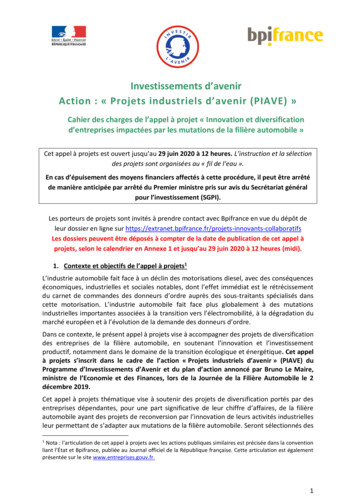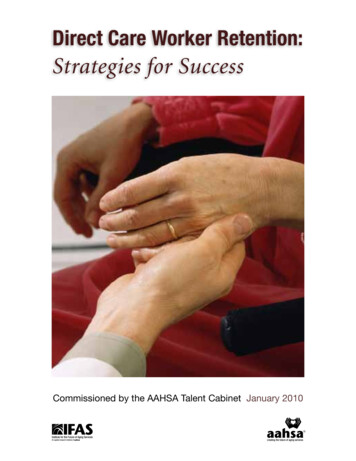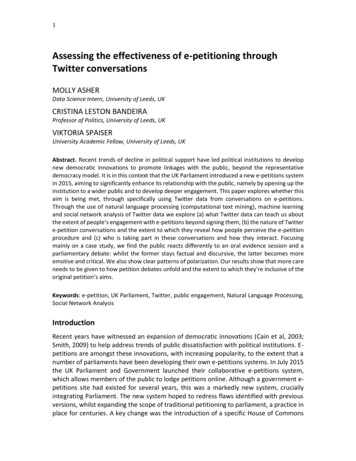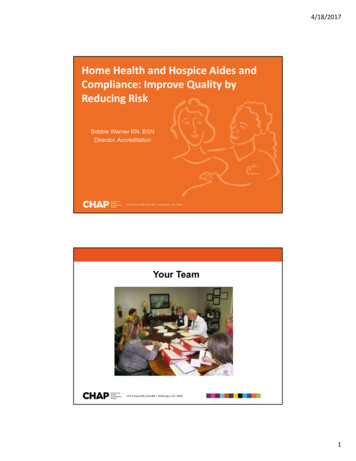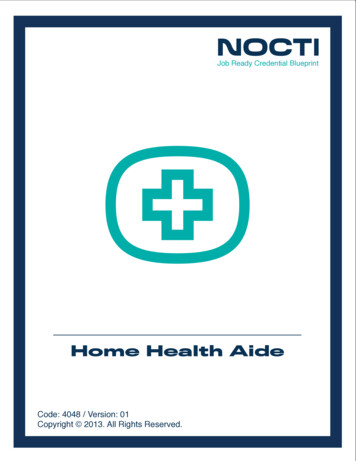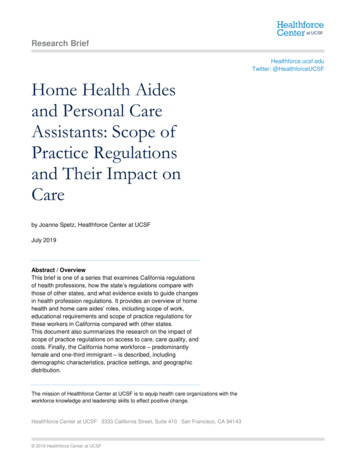
Transcription
Research BriefHealthforce.ucsf.eduTwitter: @HealthforceUCSFHome Health Aidesand Personal CareAssistants: Scope ofPractice Regulationsand Their Impact onCareby Joanne Spetz, Healthforce Center at UCSFJuly 2019Abstract / OverviewThis brief is one of a series that examines California regulationsof health professions, how the state’s regulations compare withthose of other states, and what evidence exists to guide changesin health profession regulations. It provides an overview of homehealth and home care aides’ roles, including scope of work,educational requirements and scope of practice regulations forthese workers in California compared with other states.This document also summarizes the research on the impact ofscope of practice regulations on access to care, care quality, andcosts. Finally, the California home workforce – predominantlyfemale and one-third immigrant – is described, includingdemographic characteristics, practice settings, and geographicdistribution.The mission of Healthforce Center at UCSF is to equip health care organizations with theworkforce knowledge and leadership skills to effect positive change.Healthforce Center at UCSF 3333 California Street, Suite 410 San Francisco, CA 94143 2019 Healthforce Center at UCSF
Home Health Aides and Personal Care Assistants: Scope of Practice Regulations and Their Impact on Care2AcknowledgmentsThank you to the California Health Care Foundation for funding this ew of the Profession2Scope of Practice Regulations for UnlicensedHome Care Workers5Regulations in California6Overview of Regulations in Other States7Research on the Impact of Scope of PracticeRegulationsCharacteristics of the Home Health and HomeCare Workforce in California10Numbers and Employment11Demographic ntroductionBy 2030, California’s senior population will double to 9 million, but the state faces an estimated shortage of200,000 home health and home care aides. To exacerbate the problem, California’s home health and home careaides are underutilized because of some of the most restrictive scope of practice laws in the country.This brief is one of a series that examines California regulations of health professions, how the state’s regulationscompare with those of other states, and what evidence exists to guide changes in health profession regulations. Itprovides an overview of home health and home care aides’ roles, including scope of work, educationalrequirements and scope of practice regulations for these workers in California compared with other states.This document also summarizes the research on the impact of scope of practice regulations on access to care,care quality, and costs. Finally, the California home workforce – predominantly female and one-third immigrant –is described, including demographic characteristics, practice settings, and geographic distribution.Overview of the ProfessionThis report focuses on unlicensed workers who provide long-term care services in home and community settings.Long-term care for those with temporary or permanent needs can be delivered at home or in facilities, and thereare multiple types of workers who provide care. Most long-term care is provided at home by unpaid familymembers and friends, but many people receive long-term care services that are paid by Medicare, Medicaid,private insurance, or out-of-pocket.The majority of long-term care services provide support with personal care, with a focus on "activities of dailyliving" (ADLs) that include bathing, dressing, grooming, using the toilet, eating, and moving around (such as 2019 Healthforce Center at UCSFhealthforce.ucsf.edu
Home Health Aides and Personal Care Assistants: Scope of Practice Regulations and Their Impact on Carewalking, getting out of bed, and/or into a chair). Some people need assistance with what are called instrumentalactivities of daily living (IADLs), which are not required for basic functioning but are needed to live independentlyin the community; these include cleaning the house, managing money, preparing meals, grocery shopping, usingthe telephone, and taking medications as prescribed. Care that focuses on supporting ADLs and IADLs is calledcustodial care.Some people require care in order to manage a medical condition or to rehabilitate after an acute condition suchas a heart attack or stroke. This is often called skilled care and can be provided in the home, in nursing homes,rehabilitation facilities, and in intermediate-care facilities. It is usually intended to be short-term care to help theindividual return to their original living situation, but is often associated with ongoing long-term care needs.Figure 1 summarizes the types of paid long-term care individuals might need and the settings in which thesetypes of care are provided. Those who need skilled care can receive it at home from a home health agency, or inthe institutional settings of rehabilitation/intermediate care facilities or nursing homes. For example, an individualrecovering from a hip fracture can receive physical therapy, occupational therapy, and supportive services athome, in a nursing home, or in a rehabilitation facility. Those who need custodial care – long-term support withADLs without a specific preceding health event – also can receive it in a nursing home, or in the institutionalsetting of a residential care/assisted living facility. Custodial care can be received at home from a home careorganization or by directly employing somebody to provide care. Each setting has a different regulatory andfinancing structure, and each has a different mix of staff providing services.Figure 1. Types and settings of long-term careWilliams, Brie (2014). "Consideration of Function & Functional Decline". Current Diagnosis and Treatment: Geriatrics, Second Edition. NewYork, NY: McGraw-Hill. pp. 3–4. ISBN 978-0-07-179208-0.Bookman, A., Harrington, M., Pass, L., & Reisner, E. (2007). Family Caregiver Handbook. Cambridge, MA: Massachusetts Institute ofTechnology. 2019 Healthforce Center at UCSFhealthforce.ucsf.edu3
Home Health Aides and Personal Care Assistants: Scope of Practice Regulations and Their Impact on Care4Home health agencies provide skilled care and are licensed by the California Department of Public Health(CDPH). Home health care is considered a type of medical care and thus these services are often reimbursed byprivate or public insurance for a limited period of time after a hospitalization or injury. Home health agenciesemploy: Licensed nurses: Registered nurses (RNs) and licensed vocational nurses (LVNs)Therapists: Occupational health, physical therapy, speech therapySocial service professionals: Social workers, community health workersHome health aides: Unlicensed aides who provide personal care services and are certified aftercompleting a state-approved training program or an equivalent competency evaluation program approvedby CDPHHome health aides are certified by CDPH and must renew certification every two years. As specified in theCalifornia Health and Safety Code (Division 2, Chapter 8, Section 1727), home health aides employed byhome health agencies provide personal care services under a plan of treatment prescribed by the patient’sphysician and surgeon who is licensed to practice medicine in California. Home health agencies must ensurethat aides are supervised by a registered nurse or physical, speech, or authorized occupational therapists.The initial training is 120 hours in an approved program, and home health aides must complete 12 hours ofcontinuing education per year.Home care organizations focus on custodial care. They arrange nonmedical services and assistance with ADLsand IADLs, including bathing, dressing, feeding, exercising, personal hygiene and grooming, transferring,ambulating, positioning, toileting and incontinence care, assisting with medication that the client self-administers,housekeeping, meal planning and preparation, laundry, transportation, correspondence, making telephone calls,shopping for personal care items or groceries, and companionship. They are regulated by the California HomeCare Services Bureau (HCSB), through regulations in the California Health and Safety Code (Division 2, Chapter13). Home care agencies that refer clients to home care workers but do not employ those workers do not have tobe licensed. Some home health agencies also are licensed as home care organizations. Home care organizationsemploy: Registered home care aides, who must be registered by the HCSB to provide services organized by ahome care organizationOther professionals, including licensed vocational nurses, registered nurses, therapists, social workers,and community health workersRegistered home care aides may be employed by licensed home care organizations, hospice agencies,home health agencies, or other organizations. The Home Care Services Consumer Protection Act,implemented in January 2016, created a public online registry for home care aides who have beenbackground checked. Home care aides employed by home care organizations are called “affiliated” homecare aides, and must complete five hours of entry-level training, consisting of two hours of orientationregarding their role as caregiver and 3 hours of safety training including basic safety precautions, emergencyprocedures, and infection control. They also must complete at least five hours of annual training.Home Health vs Home Care. A Place for Mom Available at: rticles/home-health-vshome-care.Home Health Aide. Available at: A.aspx. (Accessed: 8th August 2018) 2019 Healthforce Center at UCSFhealthforce.ucsf.edu
Home Health Aides and Personal Care Assistants: Scope of Practice Regulations and Their Impact on Care5Direct employment of home care aides occurs when the consumer hires, supervises, and pays home care aidesdirectly. An individual may use a payroll service to manage payment for services, but the home care aide is notemployed by an organization or service. Direct employment may occur for: Registered home care aides, who are called independent home care aidesUnregistered home care aides, because there are no regulations restricting individuals’ hiring decisionsIn-home support services (IHSS) workers, who are a specifically-designated type of home care aide hiredthrough the California In-Home Support Services program funded by Medi-Cal, and who may provideparamedical services as authorized by the IHSS programIn-home support services providers are directly selected and supervised by the consumer or theconsumer’s representative/guardian, but they are paid by county Medi-Cal programs. They must complete anorientation that includes information on IHSS program regulations, fraud, wage and hours regulations, andhow to complete timesheets. IHSS recipients have the right to hire, fire, and supervise the work of any inhome supportive services workers providing services for them. For the majority of those in the IHSS program(63.5%), family members are the paid care provider. The IHSS program is regulated by the CaliforniaWelfare and Institutions Code (Division 9, Part 3, Chapter 3).Figure 2 summarizes the types of unlicensed home care and home health workers in California.Figure 2. Types of unlicensed home care and home health workers in CaliforniaPrimary typeof employerHome healthagencyHome gistration*120 hoursCertified by CDPHPersonal careConsumer5 hoursPersonal careConsumerNoneType of careHome health aideRegistered home careaide: “affiliated”Registered home careaide: “independent”Unregistered homecare aidePersonal care specifiedby treatment planPersonal care5 hoursRegistered byHCSBRegistered byHCSBNoneOptional to beregistered byHCSBNote: *CDPH is the California Department of Public Health; HCSB is the Home Care Services Bureau.In-home supportservices providerPersonal care,paramedical servicesConsumerOrientationScope of Practice Regulations for Unlicensed Home Care WorkersHome health aides work within home health agencies to provide personal care services that are part of atreatment plan prescribed by a physician. Home health aides are supervised by a registered nurse or physical,speech, or occupational therapist. Home care aides are employed by home care organizations or directly byclients to provide personal care services. They are generally supervised by their employer, whether that is thehome care organization or the client. In most home care organizations, registered nurses (RNs) are responsiblefor client care and decisions regarding the delegation of tasks to unlicensed workers. The RN maintainsKo, M, Newcomer, R, Bindman, AB, Kang, T, Hulett, D, Spetz, J. California’s Medicaid Personal Care Assistants: Characteristics andTurnover among Family and Non-Family Caregivers. San Francisco, CA: UCSF Health Workforce Research Center on Long-Term Care. July2015. 2019 Healthforce Center at UCSFhealthforce.ucsf.edu
Home Health Aides and Personal Care Assistants: Scope of Practice Regulations and Their Impact on Care6responsibility for the overall accountability for the client, while the person completing the delegated activity hasresponsibility for that task.Regulations in CaliforniaHome health aides and registered home care aides employed by organizations or institutions (such ashome health agencies and home care agencies) are allowed to provide support for ADLs and IADLs. Medical andnursing tasks may not be delegated to home health and home care aides; this prohibition is specified inregulations governing nursing practice. The Health and Safety Code specifically says that registered home careaides are not authorized to assist with medication that the client self-administers that would otherwise requireadministration or oversight by a licensed health care professional. The California attorney general determined in1988 that regulations permit a home care aide to administer non-prescription medication but not prescriptionmedication. Support for medication administration is limited to “assisting” with self-administration, which entailsreminding the patient to take their medication or opening and closing a medication container. Placing amedication in a client’s mouth or applying a prescription cream cannot be done by a home health or home careaide. Other tasks that may not be delegated include tube feedings, inserting catheters, ostomy irrigation, bloodsugar testing for clients with diabetes, inserting enemas, and changing sterile dressings. The only medical/nursingtasks home health aides and registered home care aides can perform are aiding with special diets and helpingwith assistive devices like walkers. However, these restrictions do not apply to registered home care aides if theyare directly employed by individuals.Registered and unregistered home care aides employed by consumers in the IHSS program are permittedto perform paramedical services if ordered by a licensed health care professional and authorized by the county’sIHSS program for that consumer. The California Welfare and Institutions code explicitly states that IHSS providersmay provide paramedical services such as administration of medications, puncturing the skin or inserting amedical device into a body orifice, and activities requiring sterile procedures. Thus, an IHSS provider can insert acatheter, place a medication in a patient’s mouth, perform ostomy irrigation, and change a sterile dressing. Thisis a much wider range of permitted tasks than allowed for home health aides; the California Health and SafetyCode explicitly states that home health aide services do not include services provided under the IHSS program.Unregistered and registered home care aides directly employed by individuals not through IHSS are notrestricted in the services they provide. The work of these aides is considered a private arrangement and the aideworks under the direction of their employer. Similarly, family members are exempt from the regulatory restrictionsof the nursing practice act according to Section 2727(a).Figure 3 compares some of the tasks that different types of home care and home health workers are allowed toperform in California. IHSS providers and home care aides employed directly by the consumer are permitted toperform all tasks as directed by the consumer. In contrast, home care aides employed by home careorganizations and home health aides are significantly curtailed in the tasks they may perform.National Council of State Boards of Nursing. 2016. National Guidelines for Nursing Delegation. Journal of Nursing Regulation, 7 (1): 5–14California Business and Professions Code, Division 2. Health Arts, Chapter 6. Nursing. Article 2. Scope of Regulation.California Attorney General Opinion Letter 87-106. June 15, 1988. 06.pdfCalifornia Welfare and Institutions Code, Division 9. Public Social Services. Part 3. Aid and Medical Assistance. Chapter 3. StateSupplementary Program for Aged, Blind and Disabled. Article 7. In-Home Supportive Services.California Health and Safety Code, Division 2. Licensing Provisions, Chapter 8. Home Health Agencies. 2019 Healthforce Center at UCSFhealthforce.ucsf.edu
Home Health Aides and Personal Care Assistants: Scope of Practice Regulations and Their Impact on CareFigure 3. Selected tasks permitted for unlicensed home care and home health workers in CaliforniaADL support (e.g., bathing,dressing, transferring, eating)Home health aide(employed by homehealth agency)Yes, if in care planLimitations bar themfrom nail cuttingHome care aideemployed by homecare organizationIHSS provider, homecare aide employed byconsumerYes, with some limits(e.g., nail cutting)YesRoutine skin careYesYesYesPrevention of pressure ulcerYesNot clearly definedYesYesNot clearly definedYesNoYesYesNoNoYesOral medicationsNoNoYesEnemas/insertion ofsuppositoriesYesYesYesInjectionsNoNoYesIV fluids/infusionsNoNoYesYes (foley and ostomymaintenance)NoYesBlood sugar testingYesYesYesWound careNoNoYesTube feedingNoNoYesSuctioningNoNoYesHelping with assistive devices(e.g., walkers)YesYesYesOxygen & respiratory careNoNoYes (non medical)Complex care (ventilators,peritoneal dialysis)NoNoYesIncontinence care / PerinealcareIADL support (e.g., finances,transportation, shopping &meal prep, housecleaning)Eye drops and otherprescribed medicationsCatheter care & ostomyirrigationOverview of Regulations in Other StatesThere is substantial variation in state regulation of home health and home care aides as well as of the agenciesand organizations that employ them. Also, there is variation in regulations among those employed by agenciesversus those employed directly by consumers; 36 states allow direct employment by consumers in their Medicaidprograms such as California’s IHSS program (called “consumer-directed programs”).Medication administration provides an example of the differences in state laws. Most states allow home healthand home care aides to assist only in the self-administration of medication. In some states, medicationadministration and other tasks can be delegated by registered nurses to home health and home care aides, butthere are rules regarding which tasks and the determination of whether the aide is competent to complete thetask. Twenty states have a specific category of unlicensed worker called a medication aide to whom medicationNg T, Stone J, Harrington C. 2015. Medicaid home and community-based services: how consumer access is restricted by state policies.Journal of Aging and Social Policy 27(1):21-46. 2019 Healthforce Center at UCSFhealthforce.ucsf.edu7
Home Health Aides and Personal Care Assistants: Scope of Practice Regulations and Their Impact on Care8administration can be delegated. Finally, some states such as Texas permit registered nurses to transfer theresponsibility for some tasks to the consumer, who then can direct the home health or home care aide to performthe task. The registered nurse must determine that the consumer is competent to direct the aide and takeaccountability for their work.AARP collects information about regulations related to home care for every state and Washington, DC andreports it in their Long Term Services and Supports (LTSS) Scorecard (http://www.longtermscorecard.org/). Thelatest data, published in 2017, included information about whether each state permitted delegation of 16 specifictasks to home health and home care aides outside consumer-directed programs such as IHSS. Figure 4 lists thetasks, the number of states that permit registered nurses to delegate the tasks to home health and home careaides, and whether California regulations permit delegation. Only two tasks – administering glucometer tests andadministering enemas – can be delegated in California; few states restrict delegation of these tasks. At least halfof all states permit delegation of 14 or more of the 16 tasks.Figure 4. State regulations regarding delegation of care tasks to home health and home care aidesNumber ofstates thatpermitdelegation45TaskAdminister glucometer testDelegationpermitted inCalifornia?YesPerform ostomy care including skin care and changing appliance43NoAdminister enema41YesAdminister eye/ear Drops38NoGastrostomy tube feeding38NoAdminister oral medications37NoInsert suppository37NoPerform intermittent catheterization36NoAdminister medication on an as needed basis35NoAdminister medication via pre-filled insulin or insulin pen34NoAdminister oxygen therapy33NoPerform nebulizer treatment32NoAdminister medication through tubes31NoDraw up insulin for dosage measurement27NoAdminister intramuscular injection medications23No23NoPerform Ventilator Respiratory CareSource: AARP, 2017Figure 5 presents the count of the 16 tasks permitted for each state. Sixteen states permit delegation of all 16tasks, and another ten states permit delegation of 14 of the tasks. California is among nine states that permitdelegation of two or fewer tasks.Rachel Hammon, Texas Association for Home Care and Hospice, personal communicationAARP. 2017. Long term services and supports scorecard. http://www.longtermscorecard.org/. Raw data provided by Kathleen Ujvari, AARPPublic Policy Institute. 2019 Healthforce Center at UCSFhealthforce.ucsf.edu
Home Health Aides and Personal Care Assistants: Scope of Practice Regulations and Their Impact on Care9Figure 5. Number of key tasks that nurses can delegate to PCAs, by stateNumber oftasks0 tasks1 tasks2 tasks3 tasks5 tasks6 tasks7 tasks8 tasks9 tasks11 tasks12: tasks13 tasks14 tasks15 tasksNumber ofstates41422111113210216 tasks16Which statesFL, IN, PA, RISCAL, CA, IL, MADE, TNCT, MSKSOHLAMEWYDC, VA, WVMI, SDAZ, AR, GA, HI, MD, NH, NJ, ND, OK, WINV, NYAK, CO, ID, IA, KY, MN, MO, MT, NE, NM, NC, OR, TX, UT, VT,WASource: AARP, 2017Research on the Impact of Scope of Practice RegulationsThere is little research on the impact of home health and home care aide scope of practice and restrictiveregistered nurse delegation regulations on access to care. 14Some evidence indicates that the expansion of home health and home care aide scope of practice, particularly inthe administration of medication and other treatment plans, would allow them to provide more well-rounded carewhile reducing the workload of nurses.15 A pilot project in Australia examined the impact of expanding themedication administration authority of community care aides (CCAs), who have similar training as home healthaides in the US.16 CCAs received training in medicines support, and nurses received training in assessment,delegation and supervision. The mixed-methods evaluation of this project reported that registered nursesdeveloped high levels of trust and confidence in CCAs. In addition, nurses reported that the program reduced theneed for duplicative nurse and CCA visits, thus allowing nurses to focus their visits on clients with more complexneeds. There were no adverse medication incidents reported.Corazzini, K. N. et al. Delegation in Long-term Care: Scope of practice or job description? Online J. Issues Nurs. 15, (2010)Hewko, S. J. et al. Invisible no more: a scoping review of the health care aide workforce literature. BMC Nurs. 14, (2015). Lee, C. Y. et al.Evaluation of a support worker role, within a nurse delegation and supervision model, for provision of medicines support for older people livingat home: the Workforce Innovation for Safe and Effective (WISE) Medicines Care study. BMC Health Serv. Res. 15, 460 (2015).Lee, C. Y. et al. Evaluation of a support worker role, within a nurse delegation and supervision model, for provision of medicines support forolder people living at home: the Workforce Innovation for Safe and Effective (WISE) Medicines Care study. BMC Health Serv. Res. 15, 460(2015). 2019 Healthforce Center at UCSFhealthforce.ucsf.edu
Home Health Aides and Personal Care Assistants: Scope of Practice Regulations and Their Impact on Care10Only a few studies have examined the safety of delegation of tasks such as medication administration to homehealth and home care aides. There is no research that demonstrates that restrictive regulations improve clientsafety or outcomes.New Jersey established and evaluated a pilot program in which nurses at 19 home health agencies wereauthorized to delegate administration of medication and other tasks to certified home health aides. The evaluationrevealed no adverse outcomes to consumer health and higher levels of satisfaction for both home health aidesand consumers.17 The pilot was controversial and initially was opposed by the state nurses association, whichwanted to ensure that supervising nurses kept their authority over delegating the administration of medication, butthe association eventually supported regulatory change. In March 2016, the New Jersey Board of Nursingamended its regulations to permit nurse delegation to home health aides, provided that nurses delegate at theirown discretion and that there be an ongoing supervisory relationship between the nurse and the home healthaide.In a study of nurse delegation to unlicensed workers in multiple settings, the authors reported that there was noassociation between client outcomes and the setting, day and time of delegation, patient age, health statusstability, diagnosis, functional or cognitive ability, or the educational preparation of the nurse or direct careworker.18 Negative outcomes were more likely to occur when nurses had five or fewer years of experiencedelegating care and when unlicensed workers had less than one year of experience in their current setting.Positive outcomes were associated with regular monitoring of the unlicensed worker.AARP has actively advocated for greater authority to delegate tasks in home care settings to home health andhome care aides. According to AARP, if California improved its regulations and programs to achieve the AARPLTSS Scorecard scores of the top five states in each of the areas of (1) affordability and access; (2) choice ofsetting and provider; (3) quality of life and quality of care; (4) support for family caregivers; and (5) effectivetransitions, 176,180 more people would receive Medicaid long-term services to help with daily activities and573,100,000 more would go to home- and community-based services instead of nursing homes.19 Allowinggreater delegation of nursing tasks to home health and home care aides is one of a number of policies that wouldhelp to achieve these gains.Characteristics of the Home Health and Home Care Workforce in CaliforniaBy 2030, California’s senior population (65 and older) will double to 9 million as the youngest baby boomers reachretirement age (Figure 1). There is an immense need to expand the workforce available to care for older adults –the California Employment Development Department estimates that California will need 200,000 additional homehealth and home care aides by 2024.Sherwood, C. Home Health Aides Take On More Tasks. AARP States (2016)Anthony, M. K., Standing, T. & Hertz, J. E. Factors Influencing Outcomes After Delegation to Unlicensed Assistive Personnel. J. Nurs. Adm.30, 474 (2000).California State Scorecard - The Commonwealth Fund. Available at: ?state CA.(Accessed: 9th July 2018)California Employment Development Department. Employment Projections. mentprojections.html. 2019 Healthforce Center at UCSFhealthforce.ucsf.edu
Home Health Aides and Personal Care Assistants: Scope of Practice Regulations and Their Impact on Care11Figure 6: Projected population growth in California and percent disabled, by age, 2010-2050.9Source: Pourat, N. Home Care Quality and Safety: A Profile of Home Care Providers in California.Note: The Social Security Administration defines disability as the inability to engage in any sustainable gainfulactivity (SGA) because of a medically determined physical or mental impairment.Numbers and EmploymentNational employment data place home care aides in a category called personal care aides (StandardOccupational Classification code 39-9021), who “assist the elderly, convalescents, or persons with disabilities withdaily living activities at the person's home or in a care facility.” IHSS providers are included in this category.California has a high level of concentration of jobs for personal care aides, employing a total of 520,660 aides in2017, with 31.2 employment per thousand jobs (Figure 7). Nationally, personal care aides make up about half ofthe individual and family services industry and over 20% of the home health care industry. Nearly 80% work in theindividual and family services industry in California. Their average hourly wage in California was 12.96 per hourin 2018.ORDP.ODP. Disability Evaluation Under Social Security. Available at: https://www.ss
The mission of Healthforce Center at UCSF is to equip health care organizations with the workforce knowledge and leadership skills to effect positive change. . Direct employment of home care aides occurs when the consumer hires, supervises, and pays home care aides directly. An individual may use a payroll service to manage payment for .

